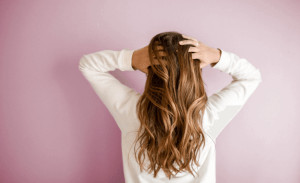Paul Mitchell Tea Tree Conditioner Review

Clean hair is happy hair, and that’s the immediate reasoning behind why we use shampoo. Conditioner, however, is a bit of a different story. Paul Mitchell introduced a product meant to put the finishing touches on your hair. The Paul Mitchell Tea Tree conditioner acts as a partner-product of the shampoo in their “tea tree” series.
Egyptologists say the Ancient Egyptians would apply almond oil to their hair for protection. Her Majesty Queen Cleopatra IV herself would use a mixture of castor oil and honey to increase the beauty and softness of her locks. I haven’t fact-checked that, but it sounds right. Those Egyptians knew what they were doing in so many other areas – storytelling, astrology, embalming, pyramid-construction – it stands to reason they were on top of high-quality hair care.
Paul Mitchell Company Overview
Paul Mitchell and his business partner, John Paul DeJoria, founded John Paul Mitchell Systems in 1980. DeJoria still manages the company and is calling the shots. Paul Mitchell died in 1989, but the brand carries on his name and legacy.
The two business partners met at a beauty show in Miami in 1971. They became friends, and as they did they formed ideas, recipes, and formulas. They basically concocted the plan for what later became the basis of their company and the professional hair care products it offers.
The duo went to work in 1980, executing their plans by selling their products door-to-door. This is therefore a classic story of the American Dream. Two friends establish a company and work hard to make it big. The two of them were dedicated and tenacious, even when – at one point – DeJoria was homeless and sleeping in his car. But their hard work and commitment paid off. Today, Paul Mitchell is worth billions.
This is a company best known for its line of professional hair care products, but also for its beauty schools and other cosmetics-related entrepreneurial endeavors. There are beauty salons which carry their products exclusively, and some which carry them alongside other companies’ products.
Take Me Straight To Buy Top Paul Mitchell Tea Tree Products
The Importance Of Conditioner For Hair Explained

Conditioning hair.
The bottom line of hair washing is that a shampoo will get your scalp clean and stimulate your follicles, but it is the hair conditioner that has the potential to provide your hair with extra softness and suppleness. Using a conditioner can assist in untangling your hair and keeping it manageable, while simultaneously helping it stay healthy, smooth, and lively.
Is it as important as shampoo? In my opinion, no. The scalp houses the roots, and the roots are the part of the hair that is actually alive. The hair that we have on our heads is essentially long strands of dead protein. Doesn’t sound too appealing, I know, but it’s true enough. Shampoo is designed more for the scalp and follicles’ benefit. Meanwhile, your conditioner is designed for the longer areas of the hair shafts themselves.
Even though the majority of our hair is dead, we still attribute great significance to it. This importance of hair has been demonstrated throughout history, and the importance of conditioner for that hair has also been plainly shown. A well-made conditioner can help you look good and feel good. That in and of itself has the potential to open many doors. When you’re having a great hair day, it helps to boost your confidence and lift your spirits. The benefits which that kind of mindset can provide with you are practically unlimited.
Taking good care of your hair is not just an egocentric, vain, or superficial practice. It could be those things, sure, but it also has to do with how you conduct yourself in the world, and how looking good and feeling good can contribute to you being a better and more well-rounded individual. It may sound ridiculous, but when we are content and happy, we are more likely to help others become content and happy.
Can a hair conditioner really help with all that? Aren’t I seriously overreaching? Perhaps. But honestly, that all may depend on the conditioner involved. If the conditioner in question has a healthy amount of tea tree essential oil in it, and other natural goodies, it may very well do the trick! After all, essential oils are some of the most powerful natural substances we have in our arsenal.
Benefits Of Tea Tree Oil Explained

Tea tree essential oil.
For countless generations, the medicinal attributes of the tea tree (and more specifically its oil) have been put to use by the Aboriginal clans of Australia. The tree’s official scientific name is Melaleuca alternifolia, but it was named tea tree after 18th century European visitors saw the native Aboriginals brewing tea from its leaves. Australia has had many successful exports over the years, and this is certainly one of the best ones. Sorry, Kylie Minogue, tea tree might have you beaten.
Tea tree oil is a highly volatile and useful substance; an antiseptic, antibacterial, anti-inflammatory agent. When properly diluted and applied, it can benefit the health of your skin, scalp, hair, nails, and more. You can use it to combat different infections and conditions, internal or external, and even as an all-purpose household cleaner. It keeps all sorts of pests at bay, and it can also act as a natural insecticide.
You can use this oil to treat cuts, wounds, abrasions, and minor injuries. It’s also effective against acne, lice, nail fungus, yeast infections, cold sores, and other unpleasant conditions.
Despite plenty of anecdotal evidence and some amount of hard clinical evidence, the oil of Melaleuca alterfornia is still considered more of a folk remedy or bush medicine (in the eyes of Western science), rather than a veritable medicine or cure. It possesses some benefits, yes, but the FDA does not categorize it as a medicine of any kind. This is true of all other essential oils and dietary supplements.
Alright, those are the overall benefits of the oil. What about the hair? How does tea tree oil assist in our mane management?
How Does Tea Tree Oil Help Condition Hair?

A good conditioner is important for your hair.
The goal of a conditioner is to untangle and replenish the hair strands. The oil of the tea tree is a substance which can do that and more: nourish, moisturize, and prevent the onset of different conditions. Its active ingredients work themselves into the hair shaft, bringing healing to areas that may need it.
Because it’s such a powerful essential oil, it’s not used as a standalone conditioner. It’s often added to the formula of existing conditioners, or as an addition to a carrier oil (e.g. coconut, olive, or almond). Tea tree oil is not for everyone’s hair. There are some who cannot use it, since it dries up their hair or leaves it too greasy. Many companies have their own version of a tea tree oil hair conditioner, and the Paul Mitchell product line is no exception. I mentioned I have a history with this company, and it is one which I look on favorably.
Paul Mitchell Tea Tree Conditioner Ingredients Breakdown
Paul Mitchell Tea Tree conditioner has a bit of a mixed formula. Some of its ingredients are really great. Substances like white ginger, aloe vera, rosemary, chamomile, jojoba, limonene, citric acid, magnesium nitrate, and of course the oil of Melaleuca alterfornia. These are all beneficial, and can aid in revitalizing the hair, as well as helping it to grow thicker, stronger, and some even say longer.
On the other hand, there are ingredients like sulfates, dyes, detergents, and the amorphic and generally-over-represented ‘fragrance’ ingredient. The latter is an ingredient which could be any number of things, and which is protected under the ‘trade secret’ act.
Not to say these ingredients don’t work – far from it. These are effective and useful ingredients, but some of them are not as natural as the others. However, since there is a good chance you won’t be using this conditioner every single day, the amount of potentially-harmful ingredients which you will be putting into your body is fairly minimal. It’s not black or white. You need to take dosage and frequency of use into account.
Read the labels of your hair and beauty products. It’s a pain in the neck, I know, and sometimes it’s dang-near impossible. Nevertheless, if you learn to identify which things are less desired for your skin, scalp, hair, and your body in general, you will be better off. There are those who claim all of the unnatural ingredients are harmful, illness-causing agents – but in many cases there is still no clear-cut clinical evidence one way or another.
Just because something says it’s safe for use every day, it doesn’t mean that you should use it every day. Everything in moderation – follow that rule, and you should be fine.
Most conditioner formulas are a mixed bag of ingredients. Obviously, the company who sells the products will want you to focus on the good stuff. In Paul Mitchell’s tea tree conditioner there are many positives, and it is almost inevitable that there will also be a few less-desired elements. Do your research, and see if it’s right for you.
Paul Mitchell Tea Tree Conditioner Review: Before And After Results
As I said, please keep in mind that this will not necessarily reflect your experience. Some conditioners are more fit for specific types of hair and hair care routines. For instance, if you usually wash your hair with shampoo and conditioner every day, this may not be the conditioner for you. I have noticed that this particular conditioner is often a “love it or hate it” type of product.
So, I used this conditioner shortly after I had been using the Paul Mitchell Tea Tree shampoo. I didn’t want to use both together, though they do complete and complement each other quite nicely, if I recall. I decided to use a different shampoo this time around, and work with the Paul Mitchell Tea Tree Conditioner for a few weeks.
It was actually good timing, because I wanted a change. My hair wasn’t in bad shape in any specific way, but my scalp was starting to flake a bit more than normal (probably because of the harsh winter that was going on then). Good timing, because I wanted to see if this conditioner would dry out my scalp and cause the flakes to multiply, or if it would prevent it from spreading. Or perhaps it would do nothing.
After a couple of uses, I could notice a change for the better. Incidentally, I can’t not mention the immensely-satisfying tingling sensation which this conditioner (and its shampoo counterpart) causes. I have used different tea tree products in my scalp and hair before, and it never fails to help me feel clean. Maybe it is just my imagination. I know it doesn’t necessarily reflect on the quality of the product itself – but I am a sucker for that prickly feeling and strong tea-tree scent.
Another thing to mention is that some conditioners are too thick or heavy, and when I rinse them out I feel like they are still in there throughout the day. This one thankfully did not have that issue, but I know it to be a common complaint. I don’t enjoy feeling like I have product in my hair when there should be none. Just something to think about, even though it wasn’t my personal experience.
The before and after results were satisfying for me. I do wish that this conditioner and its shampoo buddy would come cheaper. But that’s a separate issue I guess. Also, be on the lookout, since the Paul Mitchell tea tree shampoo and conditioner are ones which are often counterfeited. Before you purchase, make sure your product is not a knock-off.
Check it out on Amazon: Paul Mitchell Tea Tree Conditioner
DIY Natural Tea Tree Conditioner Recipe And Guide
Like so many other DIY guides, the rule of thumb here is contingent on your personal process of trial and error. Nobody can tell you exact amounts or number of uses per week which would be right for you. Anything written here or there would just be an estimate. Some DIY conditioners are rinses, some are leave-ins. This is a minimalistic kind of recipe. You can change it as you wish, and as your hair and hair routine allows.
This conditioner is meant to be applied in the shower and rinsed out after several minutes.
What you’ll need:
- 1 cup distilled water or floral water
- 2-3 tablespoons of apple cider vinegar
- 10 drops of tea tree essential oil
- Quality pump dispenser (plastic/glass) or squeeze bottle
What you’ll need to do:
- Mix the ingredients in the bottle
- Shake well and use on the hair strands, not the scalp itself
- Leave for 5 minutes and rinse out thoroughly
This amount could last for a while, but it is completely up to your hair, your needs, and your frequency of conditioning. Make sure to keep the batch away from direct sunlight and/or exposure to oxygen. Store in a cool and dark area, preferably in a sealed glass container or bottle. Essential oils and DIY products such as this could turn rancid if not cared for properly. And trust me, you don’t want rancid product in your hair.
Conclusion
Obviously, Paul Mitchell are not the only company to launch a series of hair care products that spotlight tea tree oil. Tea tree oil products are aplenty. You’ll find it in different beauty, hair care, and skin care products.
The oil of the tea tree remains one of the most useful substances in nature. It’s able to provide relief for different conditions and prevent others from presenting themselves. From cleaning the floors and keeping mosquitoes away, to treating cuts, wounds, and infections. The antiseptic and antibacterial properties of this oil cannot be ignored.
I always enjoy seeing how ancient remedies are still being used in today’s fast-paced medical and pharmaceutical world. It’s as if each generation kind of “rediscovers” these traditional cures.
If you’re interested in a conditioner which can soothe, nourish, and moisturize your hair – give the Paul Mitchell tea tree conditioner a shot, and see if it’s right for you. It could be that you and your hair will discover your next shower buddy. And if you enjoy the scent of tea tree as much as I do – score. Some say the scent is too medicinal, but I find it to be invigorating and refreshing.


